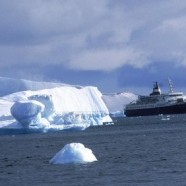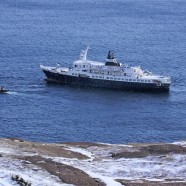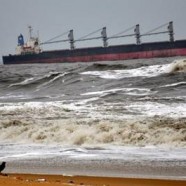Canada Vandalizes the Atlantic
Lyubov Orlova, Press release # 2
The decomissioned cruise ship Lyubov Orlova, now drifting in the Atlantic, is the responsibility of the Canadian authorities. Bearing the flag of the Cook Islands, the Lyubov Orlova was abandoned in the port of Saint John in Newfoundland in 2010, supposedly headed for demolition in the Dominican Republic after being sold by a Canadian broker to a Canadian resident of Iranian origins with interests in Saint-Domingue. Canada, the most recent country to harbour the cruise ship previously used for Arctic cruises, arranged for the Charlene Hunt, a tug boat constructed in 1962, to tow the ship on January 23. Shortly after the depart of the two ships, the tow cable broke, setting the Lyubov Orlova adrift. Due to security reasons, the Charlene Hunt was forced to return to the port of Saint-John. After the discovery of several deficiencies during the inspection of the vessel by the Canadian authorities, the Charlene Hunt must remain in port. Instead of inspecting the Charlene Hunt before its departure with the Lyubov Orlova in tow, as would have been in compliance with international maritime regulations, the Canadian authorities waited until after its return to port ; demonstrating a serious lack of foresight considering the requirements for a trans-oceanic towing.
For scrap and adrift, this is Canada’s motto
Lyubov Orlova, Press release # 1
Canada often sends its used commercial vessels to be broken up a long way away, in particular in Turkey.
In September 2011, the Canadian Miner, bound for Aliaga (Turkey) under tow, broke her towline, drifted and ran aground on Scatarie Island, in Nova Scotia. The cost of cutting and dismantling was evaluated at 24 million $. The wreck is dislocating and is a threat to the environment and the local fisheries. The Canadian Miner is still stranded on the island. The removal operations have been cancelled.
Lyubov Orlova, the ghost ship
Lyubov Orlova. IMO 7391434. Passenger ship. Length 100 m, 2,695 t. Cook Islands flag since 2009. Classification society Russian Maritime Register of Shipping. Built in 1976 in Kraljevica (Croatia) by Titovo. Detained in 2002 in Saint Petersburg (Russia). Former Soviet passenger ship owned by Far Eastern Shipping Company (Fesco) from Vladivostok ; acquired in 1986 by the Lubov Orlova Shipping Company, Malta based with Russian capital. This vessel with a capacity of 122 passengers was finally chartered by Cruise North Expeditions, an Inuit company which assigned her on their summer cruises in the Northern Canada. (Hudson and Baffin Bay …). As a result of salaries not paid to her 51 crew members and debts to her bunker suppliers she was seized on September 25th, 2010 in St John (Newfoundland, Canada). She was replaced by her sister-ship the Bahamian Clipper Adventurer (ex-Anna Tarasova) managed by International Shipping Partners, Miami. On August 27th, 2010, the Clipper Adventurer ran aground on a reef in the region of Nunavut, threatening the Canadian Arctic Ocean (Cf. “A new contaminated site in the Arctic”). The Lyubov Orlova was sold as is for an unknown destination of demolition. US $ 275 per ton.
The Seafarers Alcatraz Award 2012
The prestigious newspaper of the shipping world, the Lloyd’s List, has just attributed its awards for 2012. The “seafarer” award was attributed to the Costa Concordia’s crew.
The NGO, Robin des Bois (Robin Hood), based in Paris, would like to glorify the most dignified of the shipping community with a new prize that nobody would want to receive, the Alcatraz Award. The Seafarers Alcatraz Award could be attributed to a member of the shipping world, who, by its actions or lack of actions, inflicts upon seafarers, malnutrition, remoteness and exile. In 2012 it is attributed jointly to the port of Chennai in India and to South Korea for their leading parts in the sordid affair of the OSM Arena. Article 99 of the United Nations Convention on the Law of the Sea prohibits the transportation of slaves, however it does not prevent seafarers from being treated as slaves.
The Nisshin Maru: not to Catch but to Scrap
The Japanese government has announced that they are considering “major repairs” of the Nisshin Maru, the mother factory ship of the whaling fleet that works in Antarctica in the name of science. The work will be superficial because the Nisshin Maru should be ready in time for the departure to Antarctica which happens every year in November. The Japanese Fisheries Agency hopes that this fast cosmetic repair will resist 10 years.
However, the Nisshin Maru is old. She is fragile. She was launched in 1987.
Happy sailing in a toxic trail
MSC Flaminia
Press release # 9
PCB waste has burned in the fire following from the explosion of a container onboard MSC Flaminia on July 14th 2012 (see press release Robin De Bois, August 29, 2012). The fire raged for several days. The ship was then approximately 1800 km away from the English and French coasts. The burning of PCB generates dioxins that increased the overall toxicity of the emissions in the air and dispersed in the sea. (cf. introduction to the list of hazardous materials aboard MSC Flaminia). It is likely that the extinguishing waters inside the vessel contain PCB residues and dioxins mixed with other pollutants.
Hazardous Materials Onboard the MSC Flaminia
MSC Flaminia
Press Realease # 8
MSC Flaminia is a floating logistic warehouse. Its counterpart ground project would be subject to the Seveso Directive with strict regulation concerning construction and organizational requirements; such as fireproof walls, isolation distances between classes of hazardous materials, an internal organisation plan, a specific response plan including the intervention of external emergency resources. Fires in Seveso type plants on land requires the evacuation of people and the implementation of safety measures touching on the consumption of food produced in a perameter that can sometimes range quite far.
PCBs on board the MSC Flaminia
MSC Flaminia
Press release # 7
Update August 30, 9:45 am
The complete inventory of hazardous materials on board the MSC Flaminia has been made by an unofficial source. No radioactive material is declared. However, the big surprise is the presence of two PCB waste containers on board outside the damaged area. These PCBs are banned from production and use worldwide. They were undoubtedly intended for disposal in Europe. They came clearly the United States, since MSC Flaminia left Charleston. It is surprising that the United States would expose the marine environment to known high risks by transporting and exporting hazardous waste to Europe. Exportation from the United States to Europe is not illegal as long as done in accordance to the Basel Convention on transborder movements of hazardous waste. But it is illogical.
Is this nightmare going to end soon?
MSC Flaminia
Press release # 6 and chronology.
The MSC Flaminia’s wandering after its accident has lasted since July 14th, 2012. Until August 21, the containership in great distress, the tugs, and their crews were pushed away from French and British waters. The convoy remained in a no-man’s land, out of the range of helicopters in case of emergency. The lack of information about the kind of hazardous materials on board was a strenuous challenge to rescuers.
On July 18, after the second explosion, the first tug moved away about 2 km from the MSC Flaminia in order to avoid all risks. Simultaneously, MSC spoke of a “small explosion”.












